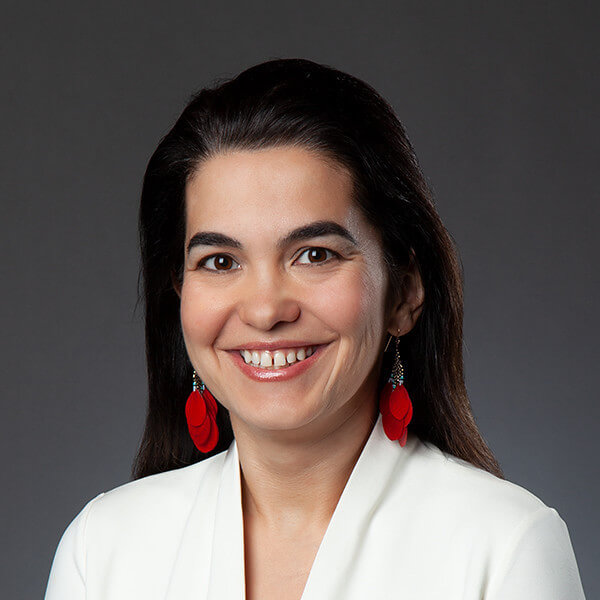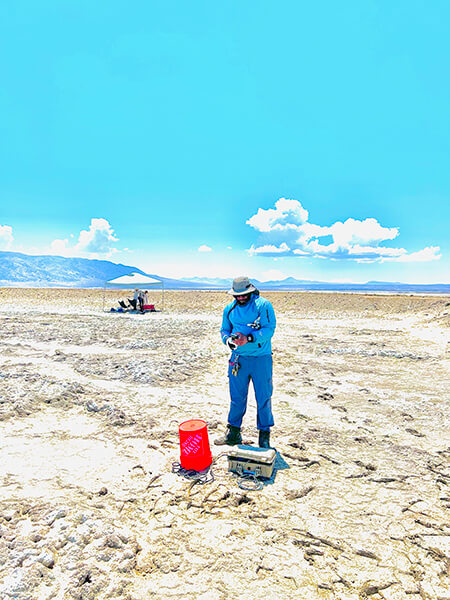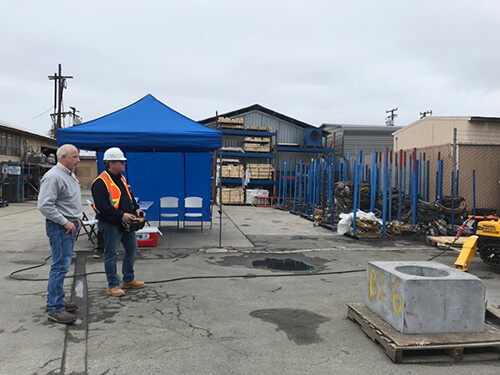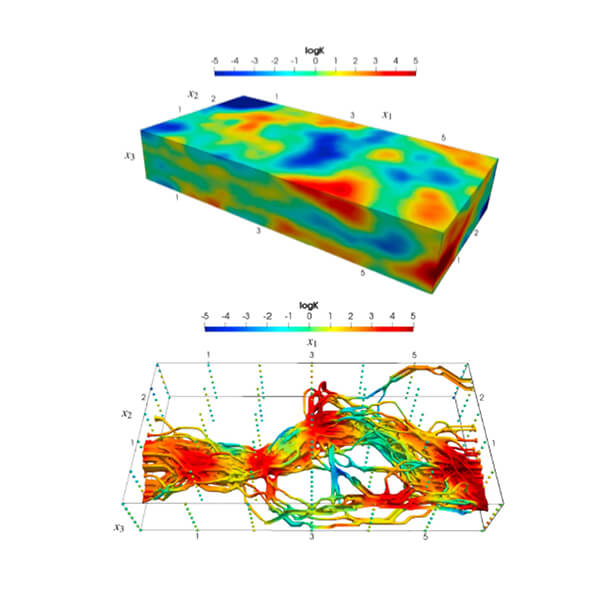Click on the circles to learn more about the multiple areas of computation-driven research at CEE
USC’s $1 billion-plus Frontiers of Computing initiative has a simple premise: in an age of AI, we are all computer scientists.
This is certainly true at Sonny Astani Department of Civil & Environmental Engineering (CEE), where methods of machine learning and data science are being combined with physics-driven computational methods to improve accuracy and efficiency in multiple areas of research and practice – from clean air and water, to intelligent transportation systems, to disaster resilience strategies.
Burçin Becerik-Gerber, chair of CEE, has long been an advocate of advanced computation in a domain of engineering too often associated with bricks-and-mortar structures and analog research methods. As Becerik-Gerber sees it, the integration of emerging technologies within the fabric of the built environment is essential for enhancing human lived experience and long-term global sustainability.
Her research into user-centric and adaptive built environments has championed the application of data-driven engineering, digital modeling and intelligent automation to enable efficient, healthy and inclusive built environments. With these principles in mind, the CEE department has developed a new strategic vision focusing on the following key areas: engineering for disaster resilience, extreme habitats, urban livability, environmental stewardship and transport service systems, each area powered by advanced computing.

Burcin Becerik-Gerber, chair of Sonny Astani Department of Civil and Environmental Engineering
“There’s a tendency for departments of civil and environmental engineering to be siloed – each researcher working on their own set of problems,” said Becerik-Gerber. “Our strategic vision directly challenges that issue. Our faculty members find themselves engaging in multiple areas of the vision, revealing the alignment of different areas of study and prompting natural collaborations.”
The research taking place within the department sets the standard for how computation methodologies are leveraged for the production of new knowledge – the concepts and data that translate to hands-on “know how,” defining best practices for industry and public policy.
Likewise, students graduating from CEE will need to be equipped with the technological toolkits and adaptive mindsets required to solve ever more complex and interconnected global problems. For this reason, computation is also central to teaching practice at CEE, woven throughout the undergraduate curriculum and foregrounded in key graduate programs such as the M.S in Advanced Design and Construction Technology and the M.S. in Green Technologies. The result is a generative feedback loop of emerging technologies for on-the-ground problem solving and global impact.
Lucio Soibelman, Fred Champion Estate Chair in Engineering est. 1967 and Professor of Civil and Environmental Engineering, worked as a construction manager for a decade before transitioning to academia, and his research supports enhanced operations and infrastructure systems through new methods of data acquisition, mining and visualization.
“We started looking into data-driven decision processes for automation in design, management and planning many years ago,” he said. “The difference is that we now have an unstoppable flow of data coming from multiple sources – from building thermostats and sensors, to drone images, to emails and digital contracts. This has completely changed the way we design, build and operate buildings and infrastructures.”
As Soibelman sees it, the availability of data is changing the professional profile of civil and environmental engineers. The ability to produce digital models and plan effectively is vital to Soibelman’s work within the fields of urban livability and extreme habitats, highlighted by his regular collaborations with Becerik-Gerber on research projects at iLAB (Innovation in Integrated Informatics) which is advancing possibilities for adaptive and responsive user-centric built environments.

Assistant Professor Chukwuebuka C. Nweke, engaged in data collection for seismic site response at Searles Dry Lake, CA
Kelly Sanders, Dr. Teh Fu Yen Early Career Chair, is implementing that “unstoppable flow of data” for the purposes of environmental stewardship. Her research interests include reducing the environmental impacts of energy and water supplies, analyzing tensions between climate change adaptation and mitigation strategies, and anticipating the effects of climate change on energy systems.
“Our Sustainable Systems Research Group uses large datasets to analyze how energy systems are impacting the environment and how climate is affecting our energy systems,” Sanders explained. “One current project involves analyzing how Californians use electricity, based on 5 years of smart meter data sourced from 200,000 homes. We also use power grid level data to understand the emissions implications of hourly variations in electricity use. For instance, here in California we use a lot of solar power in the middle of the day – so plugging in your electric car will have a different emissions profile at noon as opposed to 7pm in the evening. Big datasets and analytical techniques like machine learning are crucial for understanding how behaviors of electricity consumption impact emissions.”
Ketan Savla, John and Dorothy Shea Early Career in Civil Engineering, uses computational techniques to study and optimize transport service systems – the dynamic networks of people and products that are crucial for maintaining the momentum of human industry and societal evolution.
“Traditionally, people have thought of ground and air transportation as an applied field, rather than a field for fundamental research,” Savla asserted. “I’d like to challenge that. A lot of the conventional models we use in transportation are inspired by fluid mechanics – but now that we have data being exchanged between vehicles, we need to identify a new type of flow theory. This opens up exciting new opportunities for fundamental intellectual developments in transportation.”
One of the innovative ways that Savla is reconceptualizing the field is by utilizing algorithms that have been developed for internet congestion control. “This raises a whole new set of productive challenges,” he explained. “Internet packets move at the speed of light, but cars do not. There are a lot of physical differences between the two setups, so those algorithms have to be redesigned to manage traffic more efficiently.”
As Savla has discovered, when you’re trying to control a system where the dynamics are uncertain, you’re obliged to develop new methods. Borrowing models from other disciplines – such as digital communication networks – prompts unforeseen questions, and those questions open the way for new solutions.
Fluid mobility is a major factor in urban livability, backed by the structural health of the infrastructure that supports that flow: from roads, to bridges, to subway tunnels. Audrey Olivier applies methods of physics-based modeling, data analytics and uncertainty quantification to monitor a structure’s behavior and detect potential damage at the onset.

Professor Lucio Soibelman experimenting with a remote-operation demolition robot
“We can use the data collected from a structure to detect the earliest changes that indicate damage,” said Olivier. “We need physics-based models that allow us to predict how a structure behaves when it’s subjected to load. We also need data learning algorithms that are sufficiently accurate to detect abnormal behaviors caused by damage, in addition to being efficient enough to make real-time decisions. That’s where I come in.”
Machine learning can be applied to monitor a variety of infrastructure systems. “For example, one of our current projects involves building machine learning algorithms to accelerate contingency analysis in power grids,” Olivier continued. “If a transmission line in the power grid fails, then the grid has to rebalance itself. I work in collaboration with electrical engineers and power grid engineers who develop models that solve the physics equations to understand how power flows through a grid – the trouble is that the computations are very expensive, so my goal is to build faster and more cost-effective machine learning models.”
Olivier also emphasizes the importance of fostering trust in these algorithms – especially when it comes to managing aging infrastructure. Embedding probability and uncertainty quantification into these computations is essential for demonstrating the degree of certainty about a prediction, an area in which the department is particularly strong.
Roger Ghanem, a specialist in stochastic methods and simulation, and Felipe de Barros, who has a background in environmental fluid mechanics, are among the researchers working in this field.
For de Barros, computational models are crucial tools for visualizing and predicting what he cannot see – for instance, the potential movement of hazardous contaminants from waste disposal facilities into the groundwater that supplements our water supplies.
“My research seeks to understand how the properties of a geological medium impact the spreading and mixing rates of a contaminant plume,” he explained. “If you think of an aquifer as a series of connected sponges of different porosities and conductive properties, each ‘sponge’ provides data points that can be mapped onto a flow model. This model enables us to make predictions about groundwater flow and serves as input to other models to predict the transport of a contaminant in the subsurface environment. The output of these models assists decision makers in estimating the associated human health risk. My work combines elements from traditional computation, but also several innovations enabled by rapid increases in computational power and data sciences.”

Through 3D modeling, Associate Professor Felipe de Barros uses algorithms to generate hydraulic conductivity fields that determine preferential groundwater flow paths
de Barros is among the many CEE faculty members whose research crosses multiple areas of the department’s strategic vision, equally applicable to disaster resilience as it is to environmental stewardship. This is also true of the work of Chukwuebuka C. Nweke, who investigates seismic and other natural hazards at local and regional scales. Alongside researchers such as Patrick Lynett, who specializes in numerical modeling for understanding coastal hazards, Nweke is advancing new applications of data collection, organization and analysis to boost preparedness against natural disasters.
“My research takes two primary directions,” said Nweke. “One is pure geotechnical engineering, where I focus on understanding soil behavior and the associated mechanics. The other direction is earthquake engineering and ground motion modeling at multiple scales. Naturally, both areas involve gathering and analyzing large amounts of data. In the first instance, I perform laboratory tests that simulate real-world environmental conditions to gather enough data to establish a database that can be used to develop constitutive models. These models allow us to conduct full-scale performance evaluations of subsurface materials, such as soil, under loading from buildings, bridges, or natural disasters like earthquakes. We then plan to apply probabilistic methods to transition from the lab scale to the larger field scale representation, mapping onto actual geologic variations.”
“When it comes to research into ground motions, we already have a lot of raw data; in California, there is an outstanding number of ground motion stations that capture data every time a seismic tremor occurs. However, that wealth of information is not sufficient in itself. Not everyone understands that effective methods of computation can only take place when you contain the data in a framework that makes it simple to consume – so that’s a large part of my role, too.”
From big data to complex probabilistic modeling, methods of computation are central to research activity taking place at CEE – methods and techniques that are increasingly part of the curriculum for students. Data is knowledge, and knowledge can be applied to radically advance the quality of human life and the ecosystems in which we exist – but only if you have the right tools.
That’s where CEE researchers come in, innovating and optimizing those tools at the same time as using them to identify new insights. Data and advanced computational methods have changed the nature of the profession, what can be achieved and what can be envisioned. Computer science is not confined to 0s and 1s; it is integral to the physical systems that sustain our world.
“Civil and environmental engineers play a pivotal role in our everyday lives, harnessing the power of advanced computing to create human-centered built environments that harmonize with nature, forging a sustainable path to protect and preserve our planet,” said Becerik-Gerber. “Our faculty members at CEE are at the forefront of this movement.”
Click here to learn more about computing at CEE.
Published on October 11th, 2023
Last updated on October 11th, 2023












